Vultee BT-13 Valiant
The Vultee BT-13 Valiant was an American World War II-era basic (a category between primary and advanced) trainer aircraft built by Vultee Aircraft for the United States Army Air Corps, and later US Army Air Forces. A subsequent variant of the BT-13 in USAAC/USAAF service was known as the BT-15 Valiant, while an identical version for the US Navy was known as the SNV and was used to train naval aviators for the US Navy and its sister services, the US Marine Corps and US Coast Guard.[1]
| BT-13 Valiant | |
|---|---|
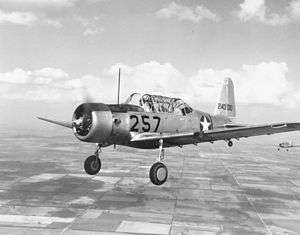 | |
| BT-13 Valiant in flight | |
| Role | Trainer |
| Manufacturer | Vultee Aircraft |
| First flight | March 1939 |
| Introduction | June 1940 |
| Primary users | United States Army Air Forces United States Navy |
| Number built | 9,525 |
Design and development
The Vultee BT-13 was the basic trainer flown by most American pilots during World War II. It was the second phase of the three phase training program for pilots. After primary training in PT-13, PT-17, or PT-19 trainers, the student pilot moved to the more complex Vultee for continued flight training. The BT-13 had a more powerful engine and was faster and heavier than the primary trainer. It required the student pilot to use two way radio communications with the ground and to operate landing flaps and a two-position Hamilton Standard controllable-pitch propeller. It did not, however, have retractable landing gear nor a hydraulic system. The flaps were operated by a crank-and-cable system. Its pilots nicknamed it the "Vultee Vibrator."
Due to the demand for this aircraft, and others which used the same Pratt & Whitney engine, some were equipped with Wright powerplants of similar size and power built in 1941–42. The Wright-equipped aircraft were designated BT-15.
The Navy adopted the P&W powered aircraft as their main basic trainer, designating it the SNV. The BT-13 production run outnumbered all other Basic Trainer (BT) types produced.[2][3][4]
In 1938, Vultee chief designer Richard Palmer began designing a single-engine fighter aircraft. About that time, the Army Air Corps issued a solicitation for an advanced trainer, with the promise of a substantial order if selected. Palmer adapted his design concept from a fighter to an advanced trainer, resulting in the V-51 prototype.

The prototype flew on 24 March 1939[5] as a cantilever low-wing monoplane of all-metal construction, with fabric-covered control surfaces. It was powered by a Pratt & Whitney R-1340-S3H1-G Wasp radial engine of 600 hp (450 kW), driving a two-blade variable-pitch metal propeller. It had an enclosed cockpit for the instructor and student, integral wing fuel tanks, and a hydraulic system to operate the flaps and retractable main landing gear.
The V-51 was entered into the USAAC competition as the BC-51 in May 1939. The USAAC instead chose the North American BC-2 in the competition, but also purchased the BC-51 prototype for further study, designating it the BC-3. Palmer refined his design, resulting in the VF-54, with the goal of selling the trainer to other countries. It used the same basic airframe as the VF-51, but was fitted with a lower powered engine. However, no export sales resulted from this proposal.
The V-54 was further refined, resulting in the VF-54A, with a well-faired fixed landing gear, manually-operated landing flaps, powered by a Pratt & Whitney R-985-T3B Wasp Jr. radial rated at 450 hp (340 kW). It was offered to the USAAC in this form, and in August 1939 the type was ordered as the BT-13. The initial order was for 300 aircraft with a Pratt & Whitney R-985-25 radial. The first aircraft was delivered to the USAAC in June 1940.
.jpg)
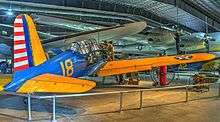
The BT-13A was produced to the extent of 7,037 aircraft and differed only in the substitution of a Pratt & Whitney R-985-AN-1 radial engine, and deletion of the landing gear fairings. 1,125 units designated BT-13B were then produced; they differed from the A model in replacing the 12v electrical system with a 24v system.
Due an industry-wide demand for the Pratt & Whitney R-985 engine, a total of 1,263 units were then produced incorporating the Wright R-975-11 engine of equal power rating. They were accepted by the USAAC as BT-15.
The US Navy also ordered 1,150 BT-13A models under the designation SNV-1. It also ordered another 650 units designated SNV-2, based on the BT-13B.
Once in service, the aircraft quickly got its nickname of "Vibrator." There are several explanations given for this nickname. 1: Because it had a tendency to shake quite violently as it approached its stall speed. 2. During more adventurous maneuvers the canopy vibrated. 3. On takeoff, the aircraft caused windows on the ground to vibrate. 4. The two-position propeller had an irritating vibration in high pitch. The BT-13 served its intended purpose well. It and its successors were unforgiving aircraft to fly, but were also extremely agile. Thus the BT-13 made a good aircraft to help transition many hundreds of pilots toward their advanced trainers and fighters yet to be mastered. The BT-13 was not without its faults. The tail was held on with only three bolts and after several in-flight failures, the Navy restricted the aircraft from aerobatic and violent maneuvers. The Navy declared the SNV obsolete in May 1945 and replaced it in the basic training role with the SNJ (T-6). The Army also replaced the BT-13 with the AT-6 before the end of the war.
After World War II, virtually all were sold as surplus for a few hundred dollars each. Many were purchased just to obtain their engines, which were mounted on surplus biplanes (such as Stearmans) to replace their less powerful engines for use as cropdusters. The BT airframes were then scrapped. Several others were modified as multi-passenger civilian aircraft; one as the "Viceroy" and at least two others by a different firm. Today, some "BT's" (collectively, BT-13s, BT-15s and SNVs) are still flying, though in very limited numbers (and none in military or government service).
Variants
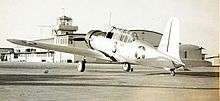
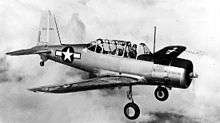
- BC-3
- Vultee Model V.51 with retractable landing gear and a 600hp P&W R-1340-45, one built, not developed.
- BT-13
- Vultee Model V.54 with fixed undercarriage and a 450hp P&W R-985-25 engine, 300 built.
- BT-13A
- As BT-13 but fitted with a 450hp R-985-AN-1 engine and minor changes, 6407 built, survivors re-designated T-13A in 1948.
- BT-13B
- As BT-13A but with a 24-volt electrical system, 1125 built.
- BT-15
- As BT-13A with a 450hp Wright R-975-11 engine, 1693 built.
- XBT-16
- One BT-13A was re-built in 1942 by Vidal with an all-plastic fuselage as the XBT-16.
- SNV-1
- BT-13As for the United States Navy, 1350 transferred from United States Army Air Corps.
- SNV-2
- BT-13Bs for the United States Navy, 650 transferred from United States Army Air Corps.
- T-13A
- Surviving BT-13As were re-designated in 1948, due to dual allocation of T-13 with the PT-13 in practice they were still known as the BT-13 to avoid confusion.
Operators
- Bolivian Air Force (37 BT-13 between 1942 and 1958)[6]
- Brazilian Air Force (120 BT-15s)[6]
- Colombian Air Force (Fourteen BT-15s)[6]
- Cuban Air Force
- Haiti Air Corps[6]
- Paraguayan Air Arm 10 BT-13A received through Lend-Lease 1942–1943. Two BT-13 bought in Argentina in 1947.
- Paraguayan Naval Aviation Three BT-13 donated by Argentina in the 1960s.
- Soviet Air Force
- Venezuelan Air Force[6]
- Centro de Instruccion Aeronautica Civil
Surviving aircraft
Australia
- Brazil
- 1072 – BT-15 on static display at the Museu Aeroespacial in Rio de Janeiro, Rio de Janeiro.[11][12]
- 42-1216 – BT-13A in storage at Museu TAM in São Carlos, São Paulo.[13]
- Canada
- 42-89379 – BT-13A airworthy in Edenvale, Ontario.[14][15]
- Indonesia
- Unknown ID – Unknown Variant on display at Museum Pusat TNI-AU Dirgantara Mandala in Jogjakarta, Indonesia.
- Unknown ID – Unknown Variant on display at Ngurah Rai International Airport in Denpasar, Bali.
- United States
.jpg)
.jpg)
- 3022 – SNV-1 on static display at Main Campus of the Kalamazoo Air Zoo in Kalamazoo, Michigan.[16][17]
- 156739 – SNV-1 airworthy at the Estrella Warbirds Museum in Paso Robles, California.[18][19][20]
- 41-10814 – BT-13A airworthy with Vultee Resource & Management in Yukon, Oklahoma.[21][22]
- 41-11355 – BT-13A on static display at the National Naval Aviation Museum in Pensacola, Florida. It is painted as an SNV-1.[23][24]
- 41-11538 – BT-13A airworthy with the Commemorative Air Force Minnesota Wing in South St. Paul, Minnesota.[25][26][27]
- 41-11584 – BT-13A on static display at the Combat Air Museum in Topeka, Kansas.[28]
- 41-21218 – BT-13A under repair to airworthy condition with Valiant Effort in Livermore, California.[29]
- 41-21487 – BT-13A on static display at the March Field Air Museum in Riverside, California.[30] It is painted as 41-22365.[31]
- 41-21933 – BT-13A on static display at the Travis Air Force Base Heritage Center at Travis Air Force Base in Fairfield, California.[32][33]
- 41-22124 – BT-13A in storage at the Paul E. Garber Preservation, Restoration, and Storage Facility of the National Air and Space Museum in Suitland, Maryland.[34]
- 41-22204 – BT-13A on static display at the South Dakota Air and Space Museum in Box Elder, South Dakota.[35]
- 41-22386 – BT-13A on static display at the Moffett Field Historical Society Museum in Mountain View, California.[36]
- 41-22441 – BT-13A airworthy at the Mid-Atlantic Air Museum in Reading, Pennsylvania.[37][38][39]
- 41-23075 – BT-13A airworthy on loan from Rene J. Vercruyssen to the Chico Air Museum in Chico, California.[40][41][42][43]
- 42-04130 – BT-13A on static display at Goodfellow Air Force Base in San Angelo, Texas.[44]
- 42-41303 – BT-15 on static display at the Gunter Annex of Maxwell Air Force Base in Montgomery, Alabama.[45][46]
- 42-42353 – BT-13A on static display at the Pima Air Museum in Tucson, Arizona.[47]
- 42-88675 – BT-13A airworthy at the National Wasp WWII Museum in Sweetwater, Texas.[48][49][50]
- 42-88708 – BT-13 on display at the Naval Air Station Wildwood Aviation Museum in Rio Grande, New Jersey.[51][52]
- 42-88855 – BT-13A airworthy with Barry D. Burns in Hubbard, Oregon.[53][54]
- 42-89607 – BT-13B airworthy at the Yanks Air Museum in Chino, California.[55][56][57]
- 42-89678 – BT-13A on static display at the Castle Air Museum in Atwater, California.[58][59]
- 42-90018 – BT-13B on static display at the Museum of Aviation at Robins Air Force Base in Warner Robins, Georgia.[60]
- 42-90026 – BT-13B airworthy with the Alaska Wing of the Commemorative Air Force in Anchorage, Alaska.[61][62][63]
- 42-90296 – BT-13B airworthy at the War Eagles Air Museum in Santa Teresa, New Mexico.[64][65][66]
- 42-90590 – BT-13B airworthy with Ryan Shively of Richland, Washington.[67] It was delivered to the USAAF in May 1944 and served with the 54th Fighter Squadron, 2nd Air Commando Group, 4501st Base Unit, and 338th Base Unit.[68]
- 42-90629 – BT-13B on static display at the National Museum of the United States Air Force in Dayton, Ohio.[69]
- 79-947 – BT-13B airworthy with the Planes of Fame Air Museum in Chino, California.[70][71]
- c/n 7832 – BT-13A on static display at the Evergreen Aviation & Space Museum in McMinnville, Oregon.[72]
- c/n 8408 – BT-13 on static display at the Fort Worth Aviation Museum in Fort Worth, Texas.[73]
- Unknown ID – Unknown variant in storage in unrestored condition at the Planes of Fame Air Museum in Chino, California.[74]
- Unknown ID – BT-13 under restoration at the Fargo Air Museum in Fargo, North Dakota.[75]
Popular culture
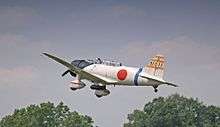
The 1942 Army training film Winning Your Wings opens with actor Jimmy Stewart landing a BT-13.
BT-13s were used by Twentieth Century Fox in the 1970 motion picture "Tora! Tora! Tora!"; 9 units were purchased in 1968 and modified to resemble Japanese "Val" dive bombers. The "Zero" fighters and "Kate" torpedo bombers in that movie were modified Harvard IV's.
After filming, the studio sold the altered aircraft to private owners. Many are still flying, several of them as part of the Commemorative Air Force's "Tora! Tora! Tora!" squadron, which performs air battle reenactments at air shows. Several "Tora" aircraft also appeared in the later "Pearl Harbor" film.
Specifications (BT-13A)
Data from United States Military Aircraft since 1909[76]
General characteristics
- Crew: 2
- Length: 28 ft 10 in (8.79 m)
- Wingspan: 42 ft 0 in (12.80 m)
- Height: 11 ft 6 in (3.51 m)
- Wing area: 239 sq ft (22.2 m2)
- Empty weight: 3,375 lb (1,531 kg)
- Gross weight: 4,496 lb (2,039 kg)
- Powerplant: 1 × Pratt & Whitney R-985-AN-1 nine-cylinder air-cooled radial engine, 450 hp (340 kW)
- Propellers: 2-bladed Hamilton-Standard 2-position
Performance
- Maximum speed: 180 mph (290 km/h, 160 kn)
- Range: 725 mi (1,167 km, 630 nmi)
- Service ceiling: 21,650 ft (6,600 m)
- Time to altitude: 9.2 minutes to 10,000 ft (3,000 m)
References
- Parker, Dana T. Building Victory: Aircraft Manufacturing in the Los Angeles Area in World War II, pp. 107–120, Cypress, CA, 2013. ISBN 978-0-9897906-0-4.
- Herman, Arthur. Freedom's Forge: How American Business Produced Victory in World War II, pp. 203, 262–3, Random House, New York, NY, 2012. ISBN 978-1-4000-6964-4.
- Parker, Dana T. Building Victory: Aircraft Manufacturing in the Los Angeles Area in World War II, pp. 107, 109, 111, 113–4, Cypress, CA, 2013. ISBN 978-0-9897906-0-4.
- Borth, Christy. Masters of Mass Production, pp. 251, 252, Bobbs-Merrill Co., Indianapolis, IN, 1945.
- Wegg 1990, p. 158.
- Wegg 1990, p. 139.
- Wegg 1990, p. 160.
- Wegg 1990, pp. 159–160.
- "Aircraft Register [VH-JKV]". Australian Government Civil Aviation Safety Authority. Retrieved 26 September 2017.
- "Airframe Dossier - Vultee BT-13A Valiant, s/n 41-23063 USAAF, c/n 7710, c/r VH-JKV". Aerial Visuals. AerialVisuals.ca. Retrieved 26 September 2017.
- "VULTEE BT-15 – VALIANT | CONSOLIDATED VULTEE AIRCRAFT". Museu Aeroespacial. Retrieved 15 November 2016.
- "Airframe Dossier – Vultee Valiant, s/n 1072 FABr, c/n 74A-3240, c/r PP-GRH". Aerial Visuals. AerialVisuals.ca. Retrieved 15 November 2016.
- "Airframe Dossier – Vultee BT-13A Valiant, s/n 42-1216 USAAF, c/r N56665". Aerial Visuals. AerialVisuals.ca. Retrieved 15 November 2016.
- "Airframe Dossier - Vultee BT-13A Valiant, s/n 42-89379 USAAF, c/r N79VV". Aerial Visuals. AerialVisuals.ca. Retrieved 26 September 2017.
- "FAA REGISTRY [N79VV]". Federal Aviation Administration. U.S. Department of Transportation. Retrieved 26 September 2017.
- "Vultee BT-13A/SNV-1 Valiant". Air Zoo. Air Zoo. Retrieved 15 November 2016.
- "Airframe Dossier – Vultee SNV-1 Valiant, s/n 03022 USN, c/n 3183". Aerial Visuals. AerialVisuals.ca. Retrieved 15 November 2016.
- "1941 Vultee SNV-1 (BT13-A) Vibrator". Estrella Warbirds Museum. Retrieved 15 November 2016.
- "Airframe Dossier – Vultee BT-13A Valiant, c/r N56319". Aerial Visuals. AerialVisuals.ca. Retrieved 15 November 2016.
- "FAA REGISTRY [N56319]". Federal Aviation Administration. U.S. Department of Transportation. Retrieved 15 November 2016.
- "FAA REGISTRY [N68178]". Federal Aviation Administration. U.S. Department of Transportation. Retrieved 26 September 2017.
- "VALIANT/41-10814". Warbird Registry. Retrieved 7 July 2020.
- "SNV VALIANT". National Naval Aviation Museum. Naval Aviation Museum Foundation. Retrieved 15 November 2016.
- "Airframe Dossier - Vultee BT-13A Valiant, s/n 41-11355 USAAF, c/n 74-2365, c/r N60828". Aerial Visuals. AerialVisuals.ca. Retrieved 26 September 2017.
- "Vultee BT-13 Valiant". Commemorative Air Force Minnesota Wing. Retrieved 15 November 2016.
- "Airframe Dossier – Vultee BT-13A Valiant, s/n 41-11538 USAAF, c/r N52411". Aerial Visuals. AerialVisuals.ca. Retrieved 15 November 2016.
- "FAA REGISTRY [N52411]". Federal Aviation Administration. U.S. Department of Transportation. Retrieved 15 November 2016.
- "Vultee BT-13A Valiant". Combat Air Museum. Combat Air Museum. Retrieved 15 November 2016.
- "Airframe Dossier - Vultee BT-13A Valiant, s/n 41-21218 USAAF, c/n 5057, c/r N59842". Aerial Visuals. Retrieved 8 June 2020.
- "BT-13 Valiant". March Field Air Museum. March Field Air Museum. Retrieved 15 November 2016.
- "Airframe Dossier – Vultee Valiant, s/n 41-21487 USAAF". Aerial Visuals. AerialVisuals.ca. Retrieved 15 November 2016.
- "Indoor Exhibits – Basic Trainers". Travis Air Force Base Heritage Center. Travis Heritage Center. Retrieved 15 November 2016.
- "Airframe Dossier – Vultee BT-13A Valiant, s/n 41-21933 USAAF, c/n 5772". Aerial Visuals. AerialVisuals.ca. Retrieved 15 November 2016.
- "Vultee BT-13A Valiant". Smithsonian National Air and Space Museum. Retrieved 29 April 2017.
- "EXHIBITS". South Dakota Air and Space Museum. Retrieved 8 June 2020.
- "Airframe Dossier - Vultee BT-13A Valiant, s/n 41-22386 USAAF, c/n 6464". Aerial Visuals. Retrieved 8 June 2020.
- Rambow, Bill. "Consolidated Vultee BT-13A/SNV-1 "Valiant"". Mid-Atlantic Air Museum. Retrieved 15 November 2016.
- "Airframe Dossier – Vultee BT-13A Valiant, s/n 41-22441 USAAF, c/r N60277". Aerial Visuals. AerialVisuals.ca. Retrieved 15 November 2016.
- "FAA REGISTRY [N60277]". Federal Aviation Administration. U.S. Department of Transportation. Retrieved 15 November 2016.
- "Chico Air Museum Photo Gallery". Chico Air Museum. Chico Air Museum. Retrieved 15 November 2016.
- Urseny, Laura (2 February 2016). "BT-13 trainer brings WWII era back to Chico airport". Chico Enterprise-Record. Chico Enterprise-Record. Retrieved 15 November 2016.
- "Airframe Dossier – Vultee BT-13A Valiant, s/n 41-23075 USAAF, c/r N59961". Aerial Visuals. AerialVisuals.ca. Retrieved 15 November 2016.
- "FAA REGISTRY [N59961]". Federal Aviation Administration. U.S. Department of Transportation. Retrieved 15 November 2016.
- Fischer, William (3 October 2008). "BT-13A Valiant". HMdb.org. Retrieved 15 November 2016.
- "LOANED AIRCRAFT BY LOC" (PDF). National Museum of the United States Air Force. Retrieved 9 June 2020.
- "Airframe Dossier – Vultee Valiant, s/n 42-41303 USAAF". Aerial Visuals. AerialVisuals.ca. Retrieved 15 November 2016.
- "VALIANT". Pima Air & Space Museum. Pimaair.org. Retrieved 15 November 2016.
- "Restored BT-13 Donated to The National WASP Museum". Warbirds News. Warbirds News. 22 September 2017. Retrieved 26 September 2017.
- "Airframe Dossier - Vultee BT-13A Valiant, s/n 42-88675 USAAF, c/n 10514, c/r N60795". Aerial Visuals. AerialVisuals.ca. Retrieved 26 September 2017.
- "FAA REGISTRY [N60795]". Federal Aviation Administration. U.S. Department of Transportation. Retrieved 26 September 2017.
- "Airplanes". Naval Air Station Wildwood Aviation Museum. NASW Aviation Museum. Retrieved 15 November 2016.
- "Airframe Dossier – Vultee BT-13 Valiant, s/n 42-88708 USAAF, c/n 10547, c/r N40018". Aerial Visuals. AerialVisuals.ca. Retrieved 15 November 2016.
- "Airframe Dossier - Vultee BT-13A Valiant, s/n 42-88855 USAAF, c/n 10990, c/r N9743N". Aerial Visuals. Retrieved 9 June 2020.
- "FAA REGISTRY [N9743N]". Federal Aviation Administration. U.S. Department of Transportation. Retrieved 9 June 2020.
- "Vultee V-79 Valiant (BT-13B)". Yanks Air Museum. Yanks Air Museum. Archived from the original on 16 November 2016. Retrieved 15 November 2016.
- "Airframe Dossier – Vultee BT-13B Valiant, s/n 42-89607 USAAF, c/n 79-0326, c/r N4425V". Aerial Visuals. AerialVisuals.ca. Retrieved 15 November 2016.
- "FAA REGISTRY [N4425V]". Federal Aviation Administration. U.S. Department of Transportation. Retrieved 15 November 2016.
- "Aircraft on Display". Castle Air Museum. Archived from the original on 14 November 2016. Retrieved 15 November 2016.
- "Airframe Dossier – Vultee BT-13A Valiant, s/n 42-89678 USAAF, c/r N63952". Aerial Visuals. AerialVisuals.ca. Retrieved 15 November 2016.
- "BT-13B "Valiant"". Museum of Aviation. Retrieved 15 November 2016.
- "BT-13 VALIANT". Commemorative Air Force Alaska Wing. Retrieved 8 June 2020.
- "Airframe Dossier - Vultee SNV-2 Valiant, s/n 42-90026 USAAF, c/n 79-0999, c/r N63282". Aerial Visuals. Retrieved 8 June 2020.
- "FAA REGISTRY [N63282]". Federal Aviation Administration. U.S. Department of Transportation. Retrieved 8 June 2020.
- "BT-13 Valiant". War Eagles Air Museum. War Eagles Air Museum. Retrieved 15 November 2016.
- "Airframe Dossier – Vultee BT-13B Valiant, s/n 42-90296 USAAF, c/n 79-1293, c/r N63697". Aerial Visuals. AerialVisuals.ca. Retrieved 15 November 2016.
- "FAA REGISTRY [N63697]". Federal Aviation Administration. U.S. Department of Transportation. Retrieved 15 November 2016.
- "FAA REGISTRY [N60794]". Federal Aviation Administration. U.S. Department of Transportation. Retrieved 8 June 2020.
- Headquarters United States Air Force Historical Research Center Maxwell Air Force Base, Alabama 36112-6678
- "Vultee BT-13B Valiant". National Museum of the US Air Force. 20 April 2015. Retrieved 15 November 2016.
- "Flying & Static Aircraft". Planes of Fame Air Museum. Retrieved 8 June 2020.
- "FAA REGISTRY [N54822]". Federal Aviation Administration. U.S. Department of Transportation. Retrieved 8 June 2020.
- Sparkes, Graham F. (18 September 2014). "VULTEE VALIANT, N57655 / 7832, EVERGREEN AVIATION AND SPACE MUSEUM". ABPic. AIR-BRITAIN. Retrieved 15 November 2016.
- "BT-13 Valiant". Fort Worth Aviation Museum. Fort Worth Aviation Museum. Retrieved 15 November 2016.
- "BT-13 wreck at the Planes of Fame Museum AZ". Wreckchasing.com. 25 September 2008. Retrieved 15 November 2016.
- "Restoration project: BT-13". Fargo Air Museum. Retrieved 6 December 2016.
- Swanborough and Bowers 1963, p. 461
- Andersson, Lennart (2008). A History of Chinese Aviation: Encyclopedia of Aircraft and Aviation in China to 1949. Taipei, Republic of China: AHS of ROC. ISBN 978-957-28533-3-7.
- Swanborough, F. G.; Bowers, Peter M. (1963). U.S. Military Aircraft since 1909. London: Putnam.
- Wegg, John (1990). General Dynamics Aircraft and their Predecessors. London: Putnam Aeronautical Books. ISBN 0-85177-833-X.
External links
| Wikimedia Commons has media related to Vultee BT-13 Valiant. |